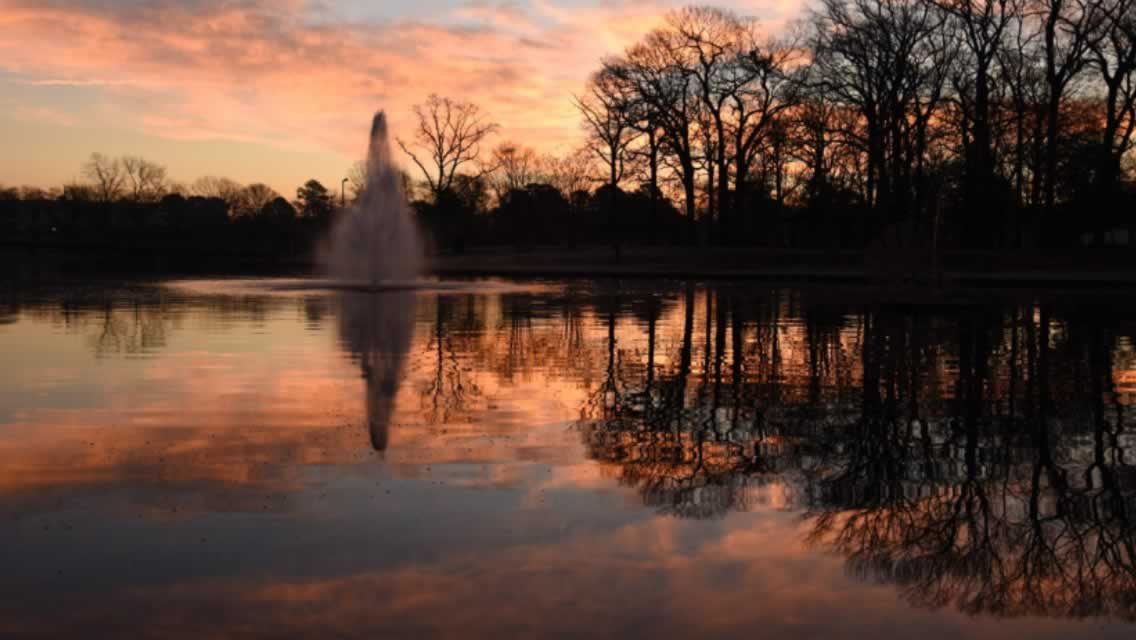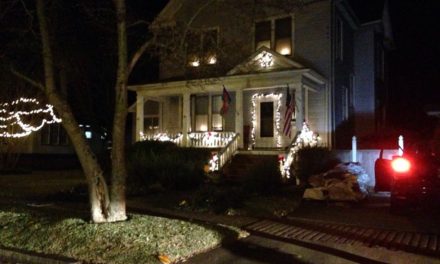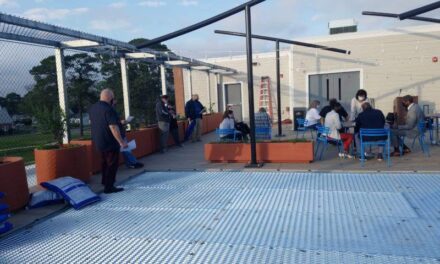By Suzy Loonam
Our beautiful lake
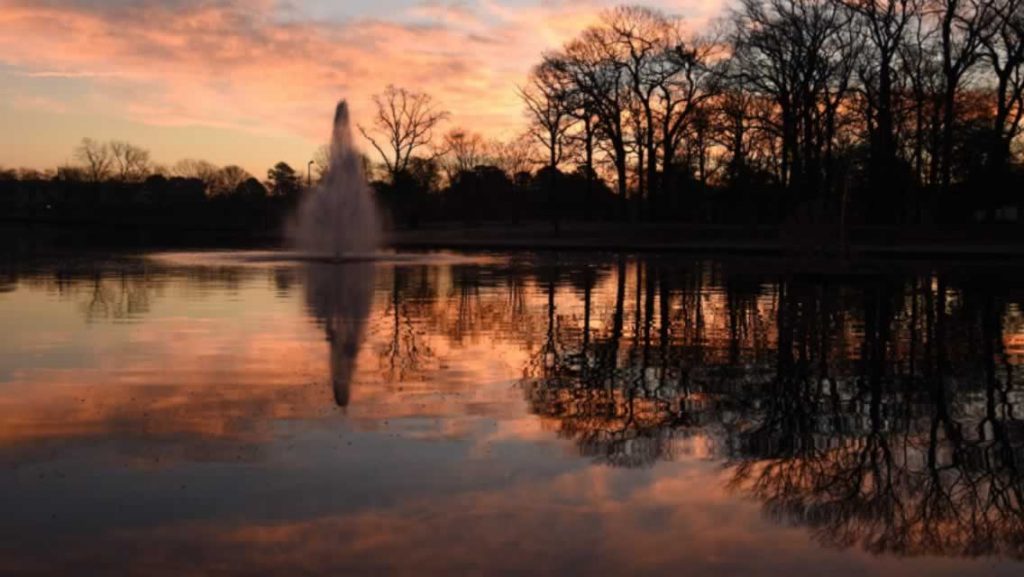
Photo by Greg Hardison. Click to enlarge.
UPDATE: Sept 5, 2019
UPDATE: Sept 11, 2019
AUG. 22, 2019 — South Norfolk, Virginia – Many South Norfolk residents and friends are surprised, saddened, horrified and disgusted with the condition of the lake at Lakeside Park, 1441 Bainbridge Blvd. in South Norfolk, Virginia.
At first glance, the lake appears stagnant and green with algae. Many Canada Geese float on top, not nearly as mired in the green goo as they look.
Our beautiful lake, the jewel of South Norfolk’s Lakeside Park, is covered end-to-end in a giant mat of algae.
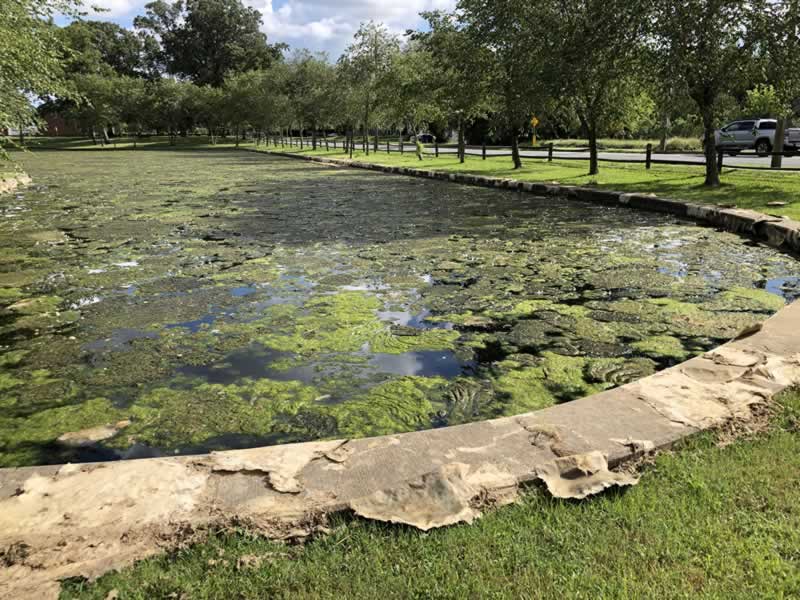
West end 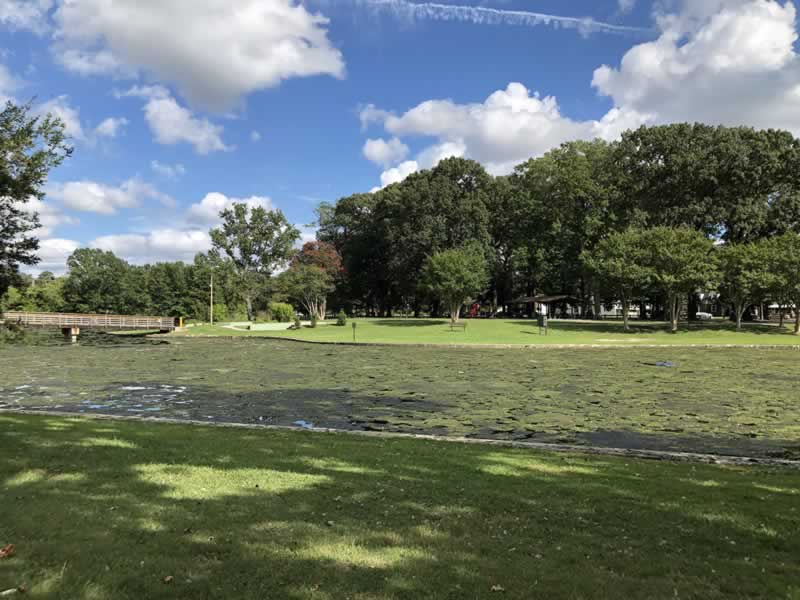
From the Holly Street side 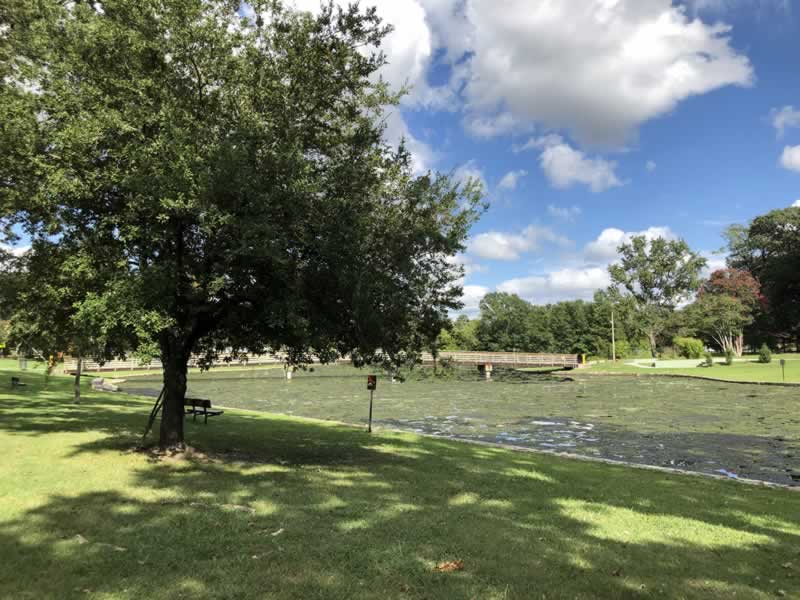
Looking east 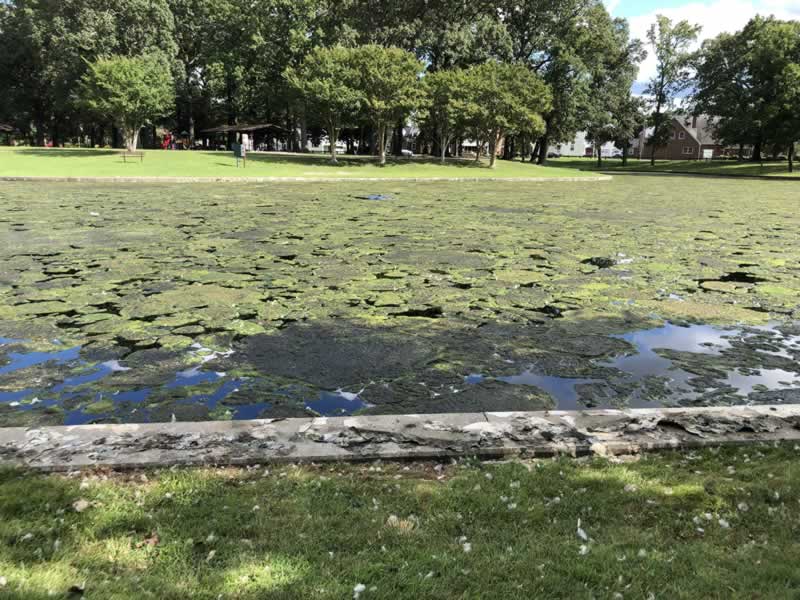
Note easy access to lake 
Slime closeup 1 
Slime closeup 2 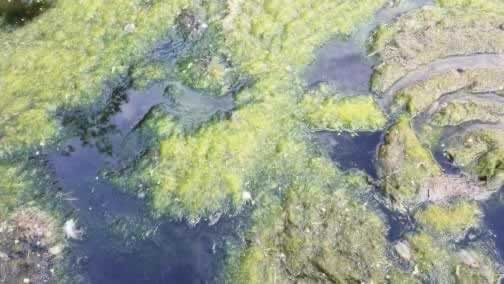
Standing over it at the lake’s edge.
“It just makes me want to cry,” said South Norfolk native and Revitalization Commissioner Vicki Josue. If it makes you want to cry, too, just wait until you hear who’s to blame!
We have met the enemy
As American naval officer Oliver Hazard Perry said in 1813, “We have met the enemy, and they are us.”
Well, truth is, he didn’t say exactly that, but the point is
the same: We, the residents of South
Norfolk, are responsible for the condition of the lake.
Yes, that’s right. WE – that’s you and me – are responsible for the algae bloom
in our lake.
Request for answers
We can’t have our community leaders and residents in tears, so we rushed a long list of questions about the lake to the city’s Department of Parks, Recreation and Tourism who requested assistance from the Department of Public Works.
It took a few days to get the answers, but there were a lot of questions, and they were all fully answered.
The memo with the answers to our questions was sent from Eric J. Martin, P.E., Director of Public Works, via Robert N. Geis, Deputy City Manager, to the mayor and city council on Monday. We and others received it by email Aug 21.
Link to city memo on city website.
The city memo also appears in content below, so download of PDF document is not required.
We are not biologists!
Anxious for answers, we two old and unsciency publishers dove headlong into researching the whole water situation ourselves. We hadn’t planned to go back to biology class, however, that is where we found ourselves. Blub, blub, blub.
Here’s what we learned:
The stuff in the lake is an algal bloom
Algae is an aquatic plant; a simple, nonflowering, and typically aquatic plant of a large group that includes the seaweeds and many single-celled forms. Algae contain chlorophyll but lack true stems, roots, leaves, and vascular tissue.
A little algae is good for the lake ecology, however the EPA says “harmful algal blooms (HABs) occur when colonies of algae grow out of control while producing toxic or harmful effects on people, fish, shellfish, marine mammals, and birds.”
Algae blooms are common in waterways in the late summer and early fall, and not just in South Norfolk or even just the south.
According to the EPA, “Harmful algal blooms are a major environmental problem in all 50 states. Red tides, blue-green algae, and cyanobacteria are examples of harmful algal blooms that can have severe impacts on human health, aquatic ecosystems, and the economy.”
Gak! What kind of algae do we have?
Our lake’s algal bloom has not yet been identified as harmful or toxic. The city plans to identify the species of algae and test the water, and will share results when they have them.
The US National Library of Medicine National Institutes of Health estimates that there may be 30,000 to more than 1 million species of algae, so identification might take some time. (UPDATE: That was a joke. Lighten up).
What caused the bloom?
The EPA says that, while they know of many factors that may contribute to HABs, the facts are murky as to how these factors come together to create a ‘bloom’ of algae.
So many factors affect the water: depth, air temperature, circulation, biomass, weather, season and chemical composition.
HABs may be linked to ‘overfeeding.’ This occurs when nutrients (mainly phosphorus, nitrogen, and carbon) from sources such as lawns and farmlands flow down and build up at a rate that ‘overfeeds’ the algae that exist normally in the environment.
Sara Says
Who’s Sara?
Sara Saunders is our independent consultant. At this time, she is not tied to any government, organization or business. She is a local marine biologist who volunteered to be quizzed by us for this article; you know… for science, since we are not biologists (as we confessed earlier).
Saunders earned her B.S. in biology with a concentration in marine biology from Saint Francis University of Loretto, Pennsylvania. She has nearly ten years’ experience as a government contractor, working as a staff biologist on several fisheries projects.
We shouldn’t brag, but our consultant received the President’s Volunteer Service Award, presented by President Trump in 2018 in recognition of her overseas volunteer work, teaching children about horticulture.
Saunders only recently returned to the area from Nagasaki, Japan where she was deployed with her navy husband. She gave her time and opinions freely for this publisher and the community of South Norfolk. We are grateful for her input.
The lake at Lakeside Park has factors working against it, Saunders said. “It’s small, circulation is low, it’s shallow, and it’s warm. And due to the topography surrounding the lake, there is a natural heavy nutrient and pollutant load from the runoff. And, are there geese?” she asked.
What can we do?
Advice from the Elizabeth River Project
Joe Rieger, Deputy Director of Restoration with the Elizabeth River Project, says there is a lot we can do! Rieger, a biologist and a project manager, gets excited when he talks about water quality.
“Everyone thinks it’s everyone else’s fault,” he explained, but the runoff is from the people who live in proximity to area waters (that is everyone in South Norfolk) who cause the amounts of harmful runoff that flows into the lake.
Rieger says an important first step is to sign up to be a “River Star Home.” River Star Homes is a free program offered by the Elizabeth River Project to help homeowners to make their homes more river friendly. “We have a contract with the City of Chesapeake to help residents reduce runoff from their properties,” he said. “People can qualify for funding of certain home projects.”
The Elizabeth River Project helps with rain barrels, rain gardens, shorelines, lawn makeovers and lawn testing.
“We encourage everyone to take advantage of the programs we offer,” Rieger said. “We can make a difference!”
To learn more and to sign up to become a River Star Home, visit https://elizabethriver.org/river-star-homes .
Our beautiful lake, with the lush green grass that carpets the areas around it and goes right up to the lake’s edge — that low-cut, well-maintained grass is making our lake a veritable goose resort.
-HistoricSouthNorfolk.com
Rieger had a recommendation for discouraging Canada Geese from choosing our lake as their home, and that is to plant mid-height shrubbery around the perimeter of the lake. “Geese don’t like to go through bushes to get to the water,” he said.
“Oh, the neighbors won’t like that,” I replied.
And then Rieger reminded me again: The cause of the lake problems stems from us, our practices and our choices.
Our beautiful lake, with the lush green grass that carpets the areas around it and goes right up to the lake’s edge — that low-cut, well-maintained grass is making our lake a veritable goose resort.
If we can accept a border of low- to mid-height greenery around the lake, Rieger says, we can effectively reduce the attractiveness of our goose haven to the flocks.
He also mentioned that the Hampton Roads Sanitation District (HRSD) has had some success with silhouette foxes, and added that those must be moved regularly to remain effective.
General advice
The city has a plan for mitigation of the algae, however we can all make some changes for the health and beauty of our lake, Scuffletown Creek, and the Elizabeth River.
- Make your home a River Star Home. Visit the River Star Home page of the Elizabeth River Project’s website at https://elizabethriver.org/river-star-homes .
- Avoid or reduce the use of detergents in your yard or driveway. These contain nitrogen and phosphorus. Algae LOVES nitrogen and phosphorus.
- Check your home sewer pipes.
- Pick up after your pets.
- Don’t use fertilizers, ESPECIALLY if you live near the lake or the creek. Even if you’re down the street from the water! It flows out of your yard, into the street and down to the water through the drainage systems, which lead to Scuffletown Creek, the lake and the Elizabeth River.
- Dispose of your DisposAll. It might be convenient to grind up your garbage right there in the sink, but the added food waste may overtax the water-treatment system.
- PLEASE DO NOT FEED DUCKS AND GEESE! Please note the geese are protected by law.
What does the city say?
PUBLISHER’s NOTE: We want to thank the city for their quick response to our very long list of questions. Answers have been provided by Barbara Brumbaugh, the Environmental Program Manager for the Department of Public Works. Visit this memo on the city’s website, here.
Below, we have reproduced the content of the city memo. We have not edited any of the city’s answers. We did correct one of our questions, changing the word “mold” for “algae.”
From Eric J. Martin, P.E. Director of Public Works, City of Chesapeake:
Recently, concerned residents in the South Norfolk neighborhood of Chesapeake have reported the appearance of algae growth in the lake at Lakeside Park on Bainbridge Blvd. The appearance and odor produced by this algae, coupled with recent media reports chronicling potential dangers of some forms of toxic algaes to people and pets, raised alarm among South Norfolk residents. The Department of Parks, Recreation and Tourism requested the assistance of the Department of Public Works in the investigation and remediation of algae in the lake, as well as to provide information that would help explain the situation at Lakeside Park to our residents.
Answers to the provided questions via Brumbaugh:
Q. Is the lake part of the local drainage system?
A. Yes, the lake provides drainage for a section of the South Norfolk neighborhood. A map of the area is attached, blue dotted lines and blue dots represent drainage pipes and structures. This drainage system is outlined in the attached PDF document.
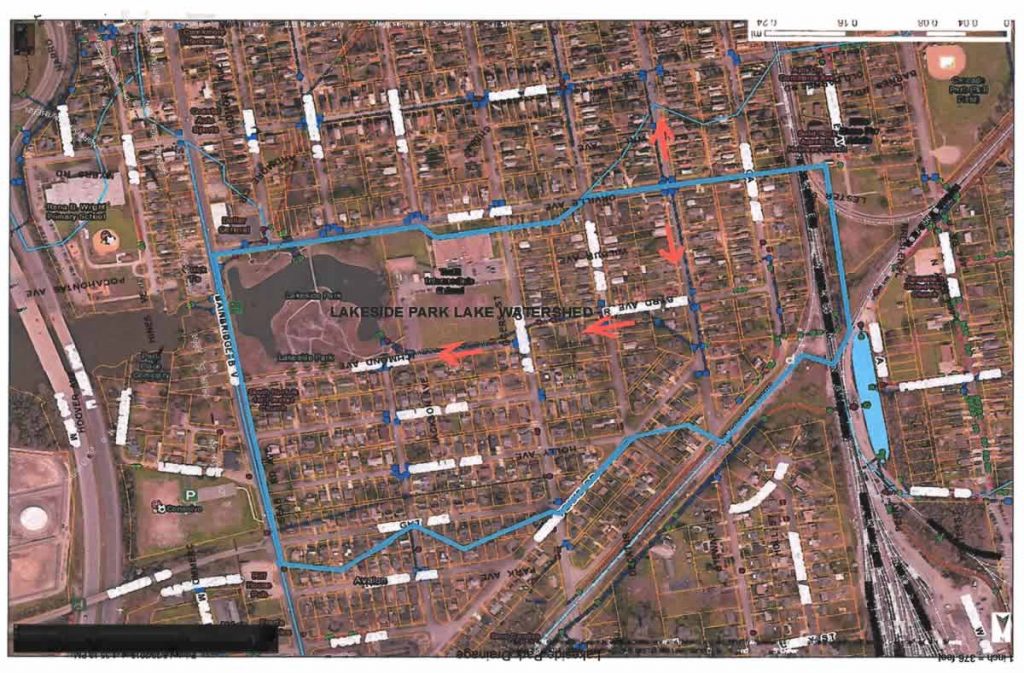
Click to enlarge.
Q. Do natural waters flow through the lake?
A. Not typically. During an unusually high tide some natural water could enter the lake from the Elizabeth River via Scuffletown Creek.
Q. Do its waters flow to the Elizabeth River?
A. Yes, flow is to Scuffletown Creek, which is part of the Elizabeth River.
Q. What steps have been taken to resolve the algae in the lake this year?
A. There have been three chemical treatments to control the algae so far this year, and another one is scheduled for Aug. 30. Given the extent of the algae problem, the City is pursuing some additional lake sampling to try to figure out the source of the excess nutrients and identify the type( s) of algae.
Q. When we hear “it’s been treated,” what does that mean, exactly? What treatments are being used?
A. Komeen liquid herbicide and Cutrine Plus granular treatment herbicide.
Q. What has been done to resolve algae blooms in years past?
A. The lake was last treated with an herbicide two years ago.
A. How does the city manage its lakes? Is there a biologist or pond treatment specialist who takes care of them all?
A. The lakes located within Chesapeake are actually stormwater treatment facilities. They collect stormwater runoff and pollutants from roads, parking lots, yards, driveways, rooftops, etc. The City inspects these facilities routinely. Problems with algae or other nuisance aquatic vegetation are managed on a case by case basis, utilizing a lake management contractor. The City relies on residents to comply with the City Stormwater Management Ordinance and keep pollutants out of the storm drainage system by taking actions such as: managing fertilizer properly and not overfertilizing; picking up pet waste; keeping grass clippings and yard debris out of the storm drains; not feeding geese or other wildlife, and keeping all pollutants away from ditches and storm drains.
Q. Why aren’t all lakes all over Chesapeake covered in algae?
A. Algae grows and thrives when the conditions are favorable, which is typically when there are excess nutrients in the lake, the water temperature is elevated (summer months), the lake is shallow and sunlight is able to penetrate to the bottom (algae needs sunlight to grow) , and there is very little movement in the water.
Q. How have lake maintenance practices changed over the years?
A. The City has recently taken a more proactive approach to controlling algae and other nuisance aquatic vegetation and has developed a Lake Management Program specifically to address nuisance aquatic vegetation which may clog or negatively impact the City’s stormwater collection and drainage system.
Q. Has the Lakeside Park lake water been tested for toxicity?
A. No. There are many species of algae, most of them are not harmful. At this time, the City does not believe that the algae at Lakeside Park is harmful.
Q. Are there plans to test the lake water?
A. Yes, for potential nutrient sources and further identification of the algae species. This will help determine if additional or different types of treatment are warranted.
Q. Is this the same toxic blue-green algae that is killing dogs?
A. We cannot provide a definitive answer at this time, but what we’ve seen is not consistent with the toxic blue-green algae that has been reported in the news recently. What we know at this time is that the lake contains duckweed and a filamentous type algae.
Q. What is happening with the fountain? Do we have algae because the fountain is broken, or is the fountain broken because we have algae?
A. The fountain is getting clogged with algae. Fountains are generally decorative features and do not circulate or aerate the large volumes of water necessary to significantly impact water quality, nor eliminate or prevent algae.
Q. Are additional fountains going to be installed?
A. The City will evaluate measures such as additional solar aerators or bubblers to improve water quality. The first step however is to reduce / eliminate the heavy nutrient flow into the lake that is contributing to the excessive algae and aquatic plant growth.
Q. Some residents have reported a foul odor. What could be causing that?
A. Dead and decaying algae will produce an unpleasant odor. There was also a recent Hampton Roads Sanitation District sanitary sewer spill on the west side of Bainbridge Blvd. that may have contributed to odor issues. The spill was cleaned up.
Q. When do you expect the lake to be clear again?
A. We’re hopeful that we’ll start seeing improvement very soon, and another treatment is scheduled for the end of August.
Q. What additional measures is the City considering?
A. Based on the success (or not) of nutrient source reduction and chemical treatment, the City may consider other measures such as a lake drawdown to dewater the lake, dry out the bottom and interrupt the growth of bottom rooted aquatic vegetation. Dredging to increase lake depth and volume is a long term possibility but requires additional engineering study and significant funding to implement.
Given that the stormwater management facilities (i.e., lakes and ponds) around the City mostly accept drainage from private property, the City has little to no control over nutrient levels which lead to algae growth. It blooms very quickly when the conditions are favorable and it is difficult to eliminate. Most of it is not harmful and will resolve on its own, although it doesn’t look attractive.
Treatment with herbicides must be completed in stages so that there is no harm to fish or other aquatic animals in the process by over-treating with herbicides. The stormwater lakes and ponds around the City are not intended for recreational use, and the City recommends that residents avoid primary contact with the water, particularly when there is algae growth.

– Barbara Brumbaugh, Environmental Program Manager, Department of Public Works.
Click to enlarge. This image was included with the city’s memo.
-end of memo-
Dredging recommended by independent consultant
Saunders, our independent marine biologist (remember her?), also reviewed the city’s memo and said the city is taking positive steps to clean up the lake at Lakeside Park. However, she recommends dredging for a more long-term solution.
“Beyond that,“ Saunders said, “adding chemicals and herbicides every year when not necessarily needed can increase potential resistance and cause a whole host of other problems.”

Unscientific findings
We did a little research of our own. We are not biologists, and we have copped to that repeatedly. We don’t play biologists on TV, so take our findings for what they are… interesting observations.
- The algae is about 3 inches thick on the surface of the lake.
- Under the algae, the water is clear and teeming with organisms.
- There is no odor. We know this as fact because our noses were within inches of the slimy green stuff for these photos. (See what we do for you?)
- We observed more than 100 geese in and around the lake in the afternoon.
- We tested the water with an H20 OK Plus Complete Water Analysis Kit (unconditionally guaranteed!) from Home Depot. (Please take that for what it’s worth).
- Our barely scientific tests, performed by laypeople in a home kitchen with no water-testing experience, showed acceptable standards for hardness, chlorine, alkalinity, PH, copper and iron. Our tests for lead and pesticides had invalid results – gasp! – which led us to suspect the validity of all other results, including a positive result for bacteria.
Actually, a positive bacteria result is expected in a lake/stormwater treatment plant, and might be found in every lake, Brumbaugh said. If the city finds anything dangerous in their tests, done in actual laboratories with actual technicians, they will let us know.
We look forward to their more complete and accurate report on the condition of our lake at Lakeside Park after city testing.
So, to sum…
- We as residents caused and can improve the condition of our lake. Every person and every home can take measures to minimize the amount of nutrients flowing into the lake. Become a River Star Home!
- The lake is ugly but the water underneath is clear and does not stink.
- City officials say most of the algae is not harmful and will resolve on its own, although they agree it doesn’t look attractive.
- The city will try to identify the species of algae and will be testing the lake waters.
- The geese are a part of the problem and they are protected by law. We can curtail them by putting greenery around the entire lake and by using silhouette fox decoys (making sure to move them regularly).
Brumbaugh said “Clean water is everyone’s responsibility. And everyone who lives in South Norfolk is eligible to become a River Star Home.” She urges everyone to take advantage of the valuable programs offered by the Elizabeth River Project.
UPDATE, SEPT. 5, 2019:
We sent more questions to Barbara Brumbaugh, Environmental Program Manager, City of Chesapeake Public Works Dept, Environmental Quality Services Division.
Here are our questions with Ms. Brumbaugh’s answers:
Q: Are there test results you can share on the water at Lakeside Park yet?
A. We don’t have any results back yet, but we have asked our contractor to proceed with conducting a phosphorus loading test on the lake and taking some algae samples for identification. I anticipate this will be done within the next 3 weeks. I’m currently working with Hampton Roads Sanitation District on the bacteria source tracking sampling that you and I discussed. They are working on a plan for that. As soon as I have results I’ll be happy to share those.
Q: We assume the lake was treated on Aug. 30 according to plan. Can you please confirm that?
A. Yes, the lake was treated on August 30th using two different herbicides.
Q: With a storm on the way, residents are concerned about flooding with the algae and trash on top and in the spillways. Is increased flooding a valid concern?
A. I don’t anticipate that the algae will cause any issues with flooding.
Q: Is there more can we do?
A: I still strongly encourage households to become River Star Homes through the Elizabeth River Project. It’s a great way to educate and engage people in protecting water quality. Moving forward, the City is exploring some options to get the algae problem under control and get a handle on it early so it doesn’t become a problem next summer.
-end-
Update: Sept. 11, 2019
We received an update on the condition of Lakeside Park via Robert N. Geis, Deputy City Manager, from Eric J. Martin, P.E., Directory of Public Works and Michael D. Barber, Director of Parks, Recreation and Tourism.
The City of Chesapeake
Department of Public Works
P.O. Box 15225 Chesapeake, Virginia 23328
(757) 382-6101
(757) 382-6310 FAX
TO: The Honorable Mayor West and Members of City Council
VIA: Robert N. Geis, Deputy City Manager
FROM: Eric J. Martin, P.E., Director of Public Works
Michael D. Barber, Director of Parks, Recreation and Tourism
DATE: September 11, 2019
SUBJECT: Lakeside Park Update
As numerous residents and visitors to South Norfolk have observed, the algae in the lake at Lakeside Park has been very problematic this summer. These are the actions that have been taken to date:
• 4 herbicide treatments: 6/22/19; 8/2/19; 8/17/19; and 8/30/19.
• The herbicide treatments to date have had limited effects on killing off the algae bloom.
• Parks, Recreation & Tourism staff have been regularly removing trash and clearing the outfall pipe grates of algae.
• The City’s lake management contractor, Resource Environmental Solutions (RES), will collect algae and phosphorus samples this month in conjunction with the next herbicide treatment. This will better identify the algae species and determine if additional types of treatments may be useful to bind up available phosphorus so it is not able to continue to feed the algae.
• Public Works staff have also requested that RES explore alternative herbicides since the ones in use have not been as effective as we’d like.
• Public Works have requested that Hampton Roads Sanitation District (HRSD) develop a sampling plan to trace any source(s) of bacteria in the lake and either confirm or rule out the presence of human sewage (“fertilizer”) in the lake. If human sources are confirmed, Public Works will work with HRSD and Public Utilities to identify and eliminate the source(s}. Waterfowl use of the lake is also very heavy and may be a contributing source of bacteria and fertilization.
• Public Works staff are exploring additional actions which may help the lake recover including aeration, draining and removing debris from the lake during the winter months.
• Hydro raking of algae is not being considered at this time other than that necessary to keep outlet pipes/grates clear.
• Public Works plans to continue having RES treat the lake with herbicides through September.
Please contact me at (757) 382-6380 if you have any questions.
EJM/ccl
Cc: Suzy Loonam, Publisher, HistoricSouthNorfolk.Com
Vicki Josue, South Norfolk Civic League
James E. Baker, City Manager
Heath Covey, Director, Public Communications
Barbara Brumbaugh, Environmental Program Manager
Tim Buma, South Norfolk Civic League President
Michael D. Barber, Director of Parks and Recreation
Joshua Fisher, City Event Coordinator
“The City of Chesapeake adheres to the principles of equal employment opportunity This policy extends to all programs and services supported by the City.”
Please visit this post on our Facebook page. That’s where all the commenting action seems to be!
Comments are “on” for this article. All are invited to comment. Comments are monitored for civility before they are published, so be nice or be censored.
###

